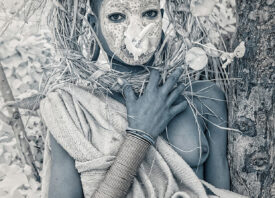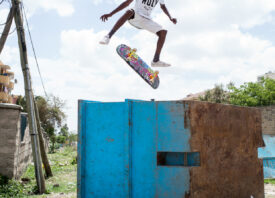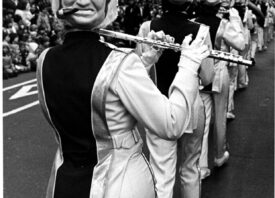Search this site
For the Bushmen of Africa, Life is a Struggle Between Tradition and Modernity
A Kalahari San Bushman climbing a tree traditionally used for firewood. The Bushman makes use of a variety of natural resources for daily life, including a whole host of wood for different purposes.
A mother and daughter, in traditional dress, perform a Bushman dance.
When documentary photographer Daniel Cuthbert drove seventeen hours into the Kalahari Desert to meet the Bushmen for the first time, the only thing he had to go by for reference was a lengthy set of co-ordinates with the message, meet us here at 4pm. On Cuthbert’s Sat Nav this spot showed up as the definition of the middle of nowhere: a no-man’s-land inaccessible by road. With a medium format Rollei 6008i, he set out into the wild nothingness of the savannah to document the Bushmen of modern-day.
Bushmen – also known as the San people – have existed in Africa for 20,000 years, but since the government started moving them into camps in attempts to eradicate their traditional lifestyle, they have been forced to adapt to a new way of life. Disappearing Cultures: The Bushman is a documentary project by Daniel Cuthbert, which looks at the lives of modern-day Bushmen and explores the struggle between tradition and modernity in a culture that is being gradually pushed towards extinction.
Cuthbert focuses on two groups – a family of Bushmen in the Kalahari Desert who still lead a somewhat traditional nomadic lifestyle, and the camps in Platfonitein where the majority of the Khwe Bushmen are now living. In these camps, alcoholism, drug abuse, and teen pregnancies are rife, simply because there is nothing for them to do. There are no job prospects, they are ostracized by other South Africans, and are denied legal citizenship and identity. The tragic reality of the situation highlighted by Cuthbert is that, “what was once one of the most self-sufficient communities on earth is now surviving on hand-outs from charities.”

Young Khwe Bushmen in Platfontein prefer western fashion for inspiration, over more traditional ways of dressing. Often the abuse they receive as Bushmen, be it when they speak their language or dress in a more traditional manner, pushes the youngsters to fit in rather than embrace their culture.
You say that it was quite a lengthy process to gain access to photograph the Bushmen. What difficulties did you encounter along the way?
“As with all good documentary projects, taking the images amounts to about 10% of the total work; the rest is spent gaining access, permission and on logistics. The Bushman project was no different, except I had to deal with numerous NGO’s and support groups to gain access to the Platfontein group and to arrange access to the family I’d be living with in Kalahari. Couple that with a round trip of 3000 kilometres for each visit, and this project pushed me on a physical level. Initially I drove for 17 hours to meet the family, which meant I wasn’t exactly the freshest when I greeted them for the first time. Then came the language barrier. I don’t speak Khwe (the traditional clicking sound), and they didn’t speak English. Cue numerous sand drawings and hand gestures.”

Teenage pregnancy is on the rise. Many young girls pretend to be pregnant after seeing the older girls in later stages of pregnancy.
Your subjects appear relatively relaxed and natural in your shots. What was their initial reaction to you photographing them? How did you gain their trust?
“At first, it was almost amusement than anything else. Here was this tall blonde guy who’s walking around, sweating like an idiot and armed with a huge black box (I was shooting with a Rollei 6008i medium format camera) and smiling and saying hello in Khwe (which I swear came out wrong, too many clicks and I bet I was insulting them whilst trying to be formal). After a few days of this, I guess I was finally ignored as the new kid and just allowed to get on with talking to people (via my translator) and finding out about their story and lives.”

Teenagers with no job prospects or aspirations turn to alcohol to pass the time. This has led to a heavy drink culture in the youth, with many spending their days idling and drinking to keep amused. ‘Why not, I love being drunk. It’s better than sitting around doing nothing. We have nothing to look forward to.’
What camera did you use to shoot this series, and why?
“I shot this project on a Rollei 6008i. I have a deep love for medium format as a medium and along with Kodak Portra 160/400 NC film stock, achieved the look and feel I wanted for this project. In addition, shooting medium format means you only have 12 frames before you need to change, so you plan the shots better, especially when it’s 36 degrees outside and the heat is melting the film. In addition to the Rollei, I had a Canon G9, which I used to show instant images to those who wanted to see. This was a huge hit with the kids and really broke the ice.”

You mentioned that the older generation were determined to preserve the traditional culture whereas the younger generation were more accepting to change. Do you feel there is a future for the Bushmen? Is anything being done to help them?
“This is actually a tough question to answer. I’ve not been in touch with the groups for a while now and I’m sure some of the situations have changed for better or for worse but at the time, the younger generation accepted the forced changed and saw a positive side. I guess this stems from the fact they’d never really lived the traditional Bushman way, whereas the older generation yearned to go back to simpler times. I think there is a future but not sure if it’s how the Bushman want to live. Forcing them to live in horrible camps in an inhospitable area isn’t the way forward. Alcoholism is now an issue and this is eroding traditional values, as is the reliance on the state for support. There are groups whose sole task is to help the Bushman, but again not having been in touch with them for a while now, I can’t say if they are succeeding in helping or not. I hope so.”

The Christian church groups have tried to convert the Bushmen to Christianity and promised donations and the construction of a church inside Platfontein. To date, this is still incomplete, however the church actively seeks new members.
 An elder Bushman lady sits in her traditional dress inside her modest home. She currently acts in a play called ‘Son of the Wind,’ which tells the story of the disaster that befell the tribes during the Angolan war for independence.
An elder Bushman lady sits in her traditional dress inside her modest home. She currently acts in a play called ‘Son of the Wind,’ which tells the story of the disaster that befell the tribes during the Angolan war for independence.






